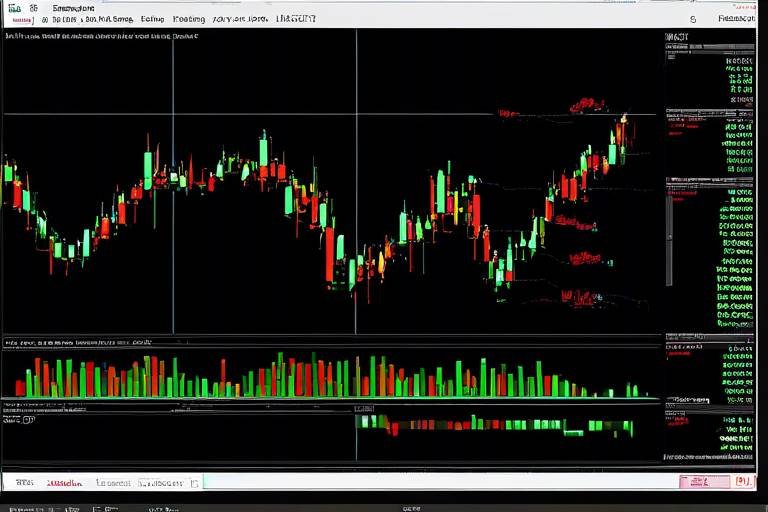Market Predictions - What Analysts Expect for Bitcoin in 2025
As we venture into the future of cryptocurrency, all eyes are on Bitcoin, the original digital currency that has captivated investors and tech enthusiasts alike. With its turbulent history marked by meteoric rises and devastating crashes, predicting Bitcoin's market performance in 2025 is no small feat. Analysts are piecing together a complex puzzle, examining various factors that could influence Bitcoin's value. From technological advancements to regulatory changes, and global economic trends, the landscape is ever-evolving. So, what can we expect for Bitcoin in 2025? Buckle up, because the ride is about to get interesting!
To understand where Bitcoin might be headed, we first need to take a look at its current state. Over the past few years, Bitcoin has experienced significant price fluctuations, with its market capitalization reaching an astonishing peak of nearly $1 trillion. However, it has also faced challenges, such as regulatory scrutiny and market volatility. Despite these hurdles, Bitcoin's adoption rates have surged, with more businesses and individuals recognizing its potential as a digital asset. As of now, Bitcoin is not just a speculative investment; it's becoming increasingly integrated into mainstream financial systems.
One of the most exciting aspects of Bitcoin's future lies in the potential for technological advancements. Innovations in blockchain technology could significantly enhance Bitcoin's scalability and security, driving its value higher. For instance, improvements in transaction speed and cost could make Bitcoin more user-friendly, appealing to a broader audience.
Layer 2 technologies, such as the Lightning Network, are at the forefront of this evolution. By enabling faster and cheaper transactions, these solutions could revolutionize how we use Bitcoin. Imagine being able to make instant payments with negligible fees—this could attract not only individual users but also businesses looking to adopt Bitcoin for everyday transactions. The adoption of Layer 2 solutions could potentially lead to a surge in Bitcoin's usability, thus positively impacting its market value.
Another game-changer could be the integration of smart contracts into the Bitcoin ecosystem. While Ethereum is often seen as the leader in smart contract functionality, Bitcoin's unique properties could allow for innovative applications. By enabling programmable transactions, smart contracts could expand Bitcoin's use cases, attracting new users and investors. This shift could create a ripple effect, enhancing Bitcoin's market position and value in the long term.
As Bitcoin continues to gain traction, the regulatory landscape is a critical factor to consider. Governments around the world are grappling with how to approach cryptocurrencies, and the decisions they make could either support or hinder Bitcoin's growth by 2025. While some countries are embracing digital currencies, others are imposing strict regulations. The outcome of these regulatory discussions will play a significant role in shaping Bitcoin's future, influencing investor confidence and market stability.
Macroeconomic trends also have a profound impact on Bitcoin's appeal. With concerns over inflation and currency devaluation, more investors are looking at Bitcoin as a potential store of value. In uncertain economic times, Bitcoin's decentralized nature and limited supply could make it an attractive alternative to traditional assets. As we move closer to 2025, these economic factors could significantly influence Bitcoin's price trajectory.
The role of institutional investors cannot be overlooked. As more hedge funds, corporations, and financial institutions enter the Bitcoin market, their influence could drive prices higher. Institutional adoption not only brings significant capital into the market but also lends legitimacy to Bitcoin as an asset class. The more mainstream Bitcoin becomes, the more likely it is to see price appreciation as demand increases.
Geopolitical events and tensions are another layer of complexity in the Bitcoin narrative. From trade wars to political instability, these factors can create uncertainty in traditional markets, leading investors to seek refuge in cryptocurrencies. As Bitcoin's global reach expands, its resilience to geopolitical events could enhance its appeal as a safe-haven asset.
Lastly, we must consider the psychological factors that drive investor behavior. Market sentiment is a powerful force in the world of cryptocurrencies, and social media plays a significant role in shaping public perception. Trends in community engagement, online discussions, and influencer endorsements can create waves of enthusiasm or skepticism that impact Bitcoin's price. Understanding these dynamics is crucial for anyone looking to navigate the cryptocurrency market.
So, what do the experts say? Predictions for Bitcoin's price in 2025 vary widely, with some analysts projecting it could reach anywhere from $100,000 to over $500,000. These forecasts are influenced by a multitude of factors, including technological advancements, regulatory developments, and macroeconomic trends. It's essential to keep in mind that while the potential for growth is immense, the cryptocurrency market is notoriously volatile, and caution is always advised.
- What is Bitcoin's current price? The price of Bitcoin fluctuates frequently; it's best to check a reliable financial news source for the most current price.
- How can I invest in Bitcoin? You can invest in Bitcoin through cryptocurrency exchanges, where you can buy, sell, and trade Bitcoin for other cryptocurrencies or fiat currencies.
- What are the risks of investing in Bitcoin? Bitcoin is highly volatile, and its price can change dramatically in a short period. Additionally, regulatory changes and security concerns can pose risks.

Current State of Bitcoin
As we dive into the , it's essential to take a step back and look at how this digital currency has evolved over the past few years. From its humble beginnings in 2009, Bitcoin has transformed from a niche technology into a mainstream financial asset. The price of Bitcoin has seen dramatic fluctuations, with peaks that have left investors both exhilarated and anxious. For instance, in December 2017, Bitcoin reached an all-time high of nearly $20,000, only to plummet to around $3,000 a year later. Fast forward to 2021, and we witnessed another surge, where Bitcoin hit an astounding $64,000. This rollercoaster ride has not only captured the attention of individual investors but also institutional players looking to diversify their portfolios.
In terms of market capitalization, Bitcoin has consistently held its position as the leading cryptocurrency, often accounting for over 40% of the total crypto market cap. This dominance is a testament to its widespread adoption and recognition as the first cryptocurrency. As of now, Bitcoin's market cap hovers around $600 billion, making it a significant player in the global financial landscape. The increasing number of wallets holding Bitcoin indicates a growing acceptance among the general public. According to recent reports, the number of Bitcoin wallets has surpassed 200 million, suggesting that more people are willing to invest in this digital asset.
Moreover, Bitcoin's adoption rates have accelerated, with many businesses now accepting it as a form of payment. Major companies, including Tesla and Square, have integrated Bitcoin into their payment systems, further legitimizing its use. This trend is crucial because it not only boosts Bitcoin's utility but also enhances its visibility in the financial sector. However, despite these advancements, Bitcoin still faces challenges, including regulatory scrutiny and environmental concerns over its energy consumption. These factors will undoubtedly play a significant role in shaping its future.
To provide a clearer picture of Bitcoin's performance, let's take a look at the following table that summarizes its price movements and market capitalization over the last few years:
| Year | Price (USD) | Market Cap (Billion USD) |
|---|---|---|
| 2017 | $13,880 | $230 |
| 2018 | $3,800 | $66 |
| 2019 | $7,200 | $128 |
| 2020 | $29,000 | $537 |
| 2021 | $64,000 | $1,200 |
| 2022 | $19,000 | $360 |
| 2023 | $30,000 | $580 |
In summary, Bitcoin's current state is a mix of excitement and uncertainty. While its price has shown resilience and a potential upward trajectory, external factors such as regulations and market sentiment will continue to influence its path. As we look ahead to 2025, understanding Bitcoin's current landscape will be crucial for making informed predictions about its future.

Technological Advancements
As we look toward the future of Bitcoin, one cannot overlook the critical role of that are poised to reshape its landscape. The cryptocurrency market is known for its rapid evolution, and Bitcoin is no exception. Innovations in blockchain technology, along with enhancements in security and scalability, are not just buzzwords; they are the backbone of what could drive Bitcoin's value higher in the coming years. Imagine Bitcoin as a high-performance sports car, and these advancements are the turbochargers that could propel it to new speeds.
One of the most exciting areas of development is the emergence of Layer 2 solutions. These technologies aim to address Bitcoin's scalability issues, which have long been a thorn in the side of its usability. The Lightning Network, for instance, allows for faster transactions and lower fees by creating off-chain payment channels. This means that instead of processing every single transaction on the Bitcoin blockchain, users can conduct transactions off the main chain and settle them later. Such a system not only enhances transaction speed but also significantly reduces congestion on the network, making Bitcoin more user-friendly. Think of it as a fast lane on a busy highway that allows cars to zip by without getting stuck in traffic.
The Lightning Network is just one example of how Layer 2 solutions can revolutionize Bitcoin's transaction capabilities. By allowing microtransactions and instant payments, it opens the door for Bitcoin to be used in everyday transactions, from buying a cup of coffee to paying for online services. The potential for increased adoption in retail and e-commerce cannot be overstated. As more merchants begin to accept Bitcoin, the demand for quick and cost-effective transactions will only grow, further driving its value.
Another exciting frontier is the integration of smart contracts within the Bitcoin ecosystem. While Ethereum is often hailed as the king of smart contracts, Bitcoin's unique attributes can also benefit from this technology. Smart contracts allow for self-executing agreements based on predetermined conditions, which can enhance Bitcoin's functionality beyond mere transactions. For instance, imagine a scenario where a smart contract automatically releases funds for a service once it has been completed. This capability could attract a new wave of users to Bitcoin, expanding its use cases and driving demand.
As these technological advancements unfold, they will likely play a pivotal role in shaping Bitcoin's market dynamics. The combination of increased transaction efficiency, reduced costs, and enhanced functionality will not only attract new users but also strengthen existing holders' confidence. After all, technology is the engine that powers innovation, and in the world of cryptocurrency, it is essential for survival and growth.
In summary, the technological advancements on the horizon for Bitcoin are not just incremental improvements; they represent a paradigm shift that could redefine its role in the global financial system. As we move closer to 2025, these developments will be crucial in determining whether Bitcoin can maintain its status as the leading cryptocurrency or if it will face challenges from emerging competitors.
- What are Layer 2 solutions? Layer 2 solutions are technologies built on top of the Bitcoin blockchain that enhance its scalability and transaction speed.
- How do smart contracts work with Bitcoin? Smart contracts are self-executing contracts with the terms directly written into code, allowing for automated transactions without intermediaries.
- Why are technological advancements important for Bitcoin? They improve usability, increase transaction efficiency, and expand Bitcoin's functionality, which can attract more users and drive its value higher.

Layer 2 Solutions
Layer 2 solutions are rapidly becoming a hot topic in the world of Bitcoin, and for good reason. As the number of transactions on the Bitcoin network continues to grow, the need for faster and cheaper transactions has become increasingly pressing. Imagine trying to send a letter during a postal strike—frustrating, right? That's how users feel when faced with slow transaction times on the Bitcoin network. Layer 2 solutions aim to alleviate these issues by providing a framework that allows for quicker transactions while maintaining the security and decentralization that Bitcoin is known for.
One of the most notable Layer 2 solutions is the Lightning Network. This technology enables users to create off-chain payment channels, allowing them to conduct transactions without needing to record every single one on the Bitcoin blockchain. Think of it as a private highway for Bitcoin transactions, where cars (transactions) can zoom by without getting stuck in traffic (the main blockchain). This not only speeds up the transaction process but also significantly reduces fees, making Bitcoin more accessible for everyday use.
Furthermore, the Lightning Network isn't just about speed; it also opens up new possibilities for microtransactions. For instance, imagine being able to tip your favorite content creator a few cents for a great article or video without the high fees that typically accompany such small transactions. This could revolutionize the way we think about value exchange online, making Bitcoin not just a store of value but a medium for everyday transactions.
However, it's essential to consider the challenges that come with implementing Layer 2 solutions. Security is a primary concern; while these technologies offer scalability, they must also ensure that users' funds are protected. Moreover, the user experience needs to be seamless. If the process of using a Layer 2 solution is too complicated, users may shy away from adopting it. Therefore, developers are working tirelessly to create user-friendly interfaces that make accessing these solutions as simple as possible.
In conclusion, Layer 2 solutions like the Lightning Network are paving the way for Bitcoin's future. By addressing the issues of speed and cost, they are not only enhancing Bitcoin's usability but also expanding its potential as a mainstream currency. As we look towards 2025, the successful integration of these solutions could be a game-changer, allowing Bitcoin to thrive in an increasingly digital economy.
- What are Layer 2 solutions? Layer 2 solutions are technologies built on top of the Bitcoin blockchain designed to improve transaction speed and reduce costs.
- How does the Lightning Network work? The Lightning Network creates off-chain payment channels that allow users to conduct transactions without recording every single one on the main blockchain.
- What are the benefits of using Layer 2 solutions? They provide faster transactions, lower fees, and enable microtransactions, enhancing Bitcoin's usability.
- Are there any risks associated with Layer 2 solutions? Yes, security and user experience are critical concerns that need to be addressed to ensure safe and easy access to these technologies.

Smart Contracts and Bitcoin
When we think about Bitcoin, the first image that usually comes to mind is that of a digital currency, a store of value, or perhaps a speculative asset. However, the integration of smart contracts could significantly expand Bitcoin's functionality and its role in the broader cryptocurrency ecosystem. Smart contracts are self-executing contracts with the terms of the agreement directly written into code. They allow for automated transactions and agreements to occur without the need for intermediaries, which can enhance efficiency and reduce costs. Imagine a vending machine that not only dispenses snacks but also allows you to purchase a concert ticket without needing a ticket booth. That's the kind of revolution smart contracts can bring to Bitcoin.
Currently, Bitcoin's scripting language is relatively simple compared to other platforms like Ethereum, which was specifically designed for smart contracts. However, there are ongoing discussions and developments aimed at enhancing Bitcoin's capabilities in this area. For instance, the introduction of Taproot, a Bitcoin upgrade implemented in late 2021, allows for more complex transactions and enhances privacy features. This upgrade could pave the way for more sophisticated smart contracts on the Bitcoin network, enabling users to create conditional transactions that execute automatically when certain conditions are met.
Imagine a scenario where you want to buy a house using Bitcoin. Traditionally, this process involves numerous parties, including real estate agents, lawyers, and banks, all of whom take a cut of the transaction. With smart contracts, the entire process could be streamlined. The contract could automatically transfer ownership once payment is confirmed, eliminating the need for intermediaries and drastically reducing transaction fees. This not only makes the process faster but also more secure, as the terms of the contract are immutable and transparent.
Moreover, the potential for smart contracts on Bitcoin could attract a new wave of users and developers to the platform, increasing its adoption and, consequently, its market value. As more people recognize the advantages of using Bitcoin for complex transactions, we might see a shift in how Bitcoin is perceived—from merely a digital currency to a versatile platform capable of supporting a wide range of applications.
However, it's important to note that while the potential is enormous, there are still challenges to overcome. Issues related to scalability and transaction speed must be addressed to ensure that Bitcoin can handle the increased load that smart contracts would bring. Additionally, regulatory uncertainty surrounding cryptocurrencies could pose a risk to the widespread adoption of smart contracts on the Bitcoin network.
In conclusion, the integration of smart contracts into the Bitcoin ecosystem represents a significant opportunity for growth and innovation. As the technology matures and more developers explore its possibilities, we could witness a transformation in how Bitcoin is utilized, pushing it further into the mainstream and solidifying its position as a leading cryptocurrency. The future is bright, and the potential is enormous—who knows what the next few years will bring?
- What are smart contracts?
Smart contracts are self-executing contracts with the terms of the agreement directly written into code, allowing for automated transactions without intermediaries. - How can smart contracts benefit Bitcoin?
Smart contracts can enhance Bitcoin's functionality, streamline complex transactions, reduce costs, and increase user adoption. - Are there any challenges to implementing smart contracts on Bitcoin?
Yes, challenges include scalability, transaction speed, and regulatory uncertainty that could hinder widespread adoption.

Regulatory Landscape
The regulatory landscape surrounding Bitcoin and cryptocurrencies is as dynamic as the digital assets themselves. In recent years, we've witnessed a whirlwind of regulatory changes that have left investors and enthusiasts on the edge of their seats. As we look towards 2025, understanding the potential regulatory environment is crucial for predicting Bitcoin's future. The actions taken by governments and regulatory bodies can significantly influence market behavior, either fostering growth or stifling innovation.
Many countries are grappling with how to effectively regulate Bitcoin without hindering its decentralized nature. For instance, some jurisdictions have embraced cryptocurrencies, creating favorable legislation that encourages innovation and investment. Others, however, have taken a more cautious approach, implementing stringent regulations that could deter participation. This dichotomy creates a complex environment for Bitcoin, where the regulatory framework can vary dramatically from one region to another.
As we anticipate the regulatory developments leading up to 2025, several key factors will likely come into play:
- Legislation on Taxation: Governments may introduce clearer guidelines on how Bitcoin transactions are taxed. This could encourage more people to engage with Bitcoin if they understand the tax implications.
- Consumer Protection Laws: As Bitcoin gains popularity, the need for consumer protection becomes paramount. Regulations that safeguard investors against fraud and scams could enhance market confidence.
- AML and KYC Regulations: Anti-Money Laundering (AML) and Know Your Customer (KYC) regulations are expected to become more stringent, which may affect how exchanges operate and how users interact with Bitcoin.
Moreover, the role of international regulatory bodies cannot be overlooked. As cryptocurrencies transcend borders, there is a growing call for a unified global framework that addresses the challenges posed by digital currencies. This could lead to more consistent regulations, which would benefit both investors and the market as a whole.
On the flip side, the potential for regulatory crackdowns still looms. Governments might impose restrictions on Bitcoin mining due to environmental concerns or limit the use of cryptocurrencies in certain transactions. These actions could lead to increased volatility in the market, causing investors to think twice before diving in.
In summary, the regulatory landscape for Bitcoin by 2025 will be shaped by a combination of local and global policies. Investors and stakeholders must remain vigilant and adaptable as they navigate this evolving environment. Understanding these regulations will be key to leveraging Bitcoin's potential while mitigating risks associated with regulatory uncertainties.
1. How do regulations affect Bitcoin's price?
Regulations can create uncertainty in the market, leading to price volatility. Positive regulatory developments may boost investor confidence and drive prices up, while negative regulations can have the opposite effect.
2. Will Bitcoin ever be fully regulated?
While complete regulation may be challenging due to Bitcoin's decentralized nature, it is likely that governments will impose regulations to protect consumers and ensure financial stability.
3. What are the risks of investing in Bitcoin due to regulations?
Investors face risks such as sudden regulatory changes that could impact market access, increased compliance costs for exchanges, and potential legal repercussions for non-compliance.
4. Can regulations help Bitcoin's adoption?
Yes, clear and favorable regulations can enhance Bitcoin's legitimacy, encouraging more businesses and individuals to adopt it as a legitimate form of currency and investment.

Global Economic Factors
The landscape of global economics is a complex tapestry, woven with threads of inflation, currency fluctuations, and geopolitical tensions. As we look ahead to 2025, these factors will play a crucial role in shaping Bitcoin's appeal as a viable store of value. Imagine Bitcoin as a lifeboat in a tumultuous sea; when traditional currencies face storms of instability, more people may turn to the safety of cryptocurrencies. This analogy highlights the potential for Bitcoin to thrive in uncertain economic conditions.
One of the primary economic factors influencing Bitcoin's position will be inflation. As central banks around the world continue to print money to stimulate economies, the purchasing power of fiat currencies may diminish. In such a scenario, Bitcoin could emerge as a hedge against inflation, attracting investors who are looking to preserve their wealth. Historical data suggests that during periods of high inflation, Bitcoin's value tends to rise as more individuals seek alternatives to traditional currencies. For instance, during the COVID-19 pandemic, we witnessed a surge in Bitcoin's price as governments implemented extensive monetary policies.
Furthermore, the devaluation of national currencies can significantly impact Bitcoin's market dynamics. Countries experiencing economic turmoil, such as hyperinflation or severe currency depreciation, often see an increase in Bitcoin adoption. In 2025, if we observe continued economic instability in regions like Latin America or parts of Africa, we could witness a spike in Bitcoin transactions as people turn to this digital asset for financial security. This trend is already evident in countries like Venezuela, where citizens have increasingly relied on Bitcoin to escape the clutches of their collapsing economy.
In addition to inflation and currency issues, geopolitical tensions can also affect Bitcoin's trajectory. Trade wars, sanctions, and conflicts can create uncertainty in global markets, driving investors towards assets perceived as safer, like Bitcoin. For example, during times of heightened geopolitical risks, we often see a correlation between Bitcoin's price and investor sentiment. The more unstable the world feels, the more people may flock to cryptocurrencies as a hedge against chaos.
To further illustrate these points, let’s take a look at a table that summarizes the potential impacts of various global economic factors on Bitcoin's adoption and value by 2025:
| Economic Factor | Impact on Bitcoin |
|---|---|
| Inflation | Increased demand as a hedge against eroding purchasing power |
| Currency Devaluation | Greater adoption in countries with unstable currencies |
| Geopolitical Tensions | Heightened interest as a safe-haven asset |
In conclusion, the global economic landscape in 2025 will be pivotal for Bitcoin's growth and acceptance. As investors become more aware of the potential risks associated with traditional currencies, the demand for Bitcoin may surge. This shift could lead to a more significant integration of Bitcoin into everyday financial practices, fundamentally altering how we perceive value in an increasingly digital world. So, as we navigate these turbulent waters, will Bitcoin be your lifeboat, or will you choose to stay aboard the sinking ship of traditional finance?
- What is the primary factor that could influence Bitcoin's price by 2025? Inflation and currency devaluation are expected to be major factors driving Bitcoin's demand.
- How do geopolitical tensions affect Bitcoin? Increased geopolitical instability often leads investors to seek safe-haven assets like Bitcoin, potentially driving up its price.
- Can Bitcoin serve as a hedge against inflation? Yes, many investors view Bitcoin as a hedge against inflation, especially during times of economic uncertainty.

Institutional Adoption
The landscape of Bitcoin is rapidly evolving, and one of the most significant drivers of this change is . Over the past few years, we've witnessed a remarkable shift where large financial institutions, hedge funds, and even corporations have started to take Bitcoin seriously. This is not just a passing trend; it signifies a growing recognition of Bitcoin as a legitimate asset class. But what does this mean for the future? Well, let's dive into it!
Historically, Bitcoin was seen as the playground for retail investors and tech enthusiasts, but now, it’s attracting the attention of major players in the finance world. This transition is akin to a small-town diner suddenly becoming a hotspot for celebrity sightings. When institutions start to invest in Bitcoin, it brings a level of credibility and stability that can significantly influence market dynamics. For instance, companies like Tesla and MicroStrategy have made headlines with their substantial Bitcoin purchases, showcasing a willingness to embrace digital currencies as part of their financial strategy.
So, why are institutions interested in Bitcoin? One of the primary reasons is the potential for diversification in their investment portfolios. Bitcoin is often viewed as a hedge against inflation and currency devaluation, especially in times of economic uncertainty. As central banks around the world engage in aggressive monetary policies, institutional investors are looking for assets that can retain value. Bitcoin, with its capped supply of 21 million coins, presents an attractive option.
Furthermore, the increasing availability of regulated financial products related to Bitcoin, such as ETFs (Exchange-Traded Funds), has made it easier for institutions to gain exposure to this digital asset without directly holding it. This shift is crucial because it lowers the barriers to entry for traditional investors who may have been hesitant to dive into the somewhat murky waters of cryptocurrency.
To illustrate this growing trend, consider the following table that outlines some key statistics regarding institutional investment in Bitcoin:
| Institution | Investment Amount (in billions) | Date of Investment |
|---|---|---|
| MicroStrategy | 3.16 | August 2020 |
| Tesla | 1.5 | February 2021 |
| Square (now Block, Inc.) | 0.50 | October 2020 |
| Galaxy Digital | 0.01 | March 2021 |
As we look towards 2025, the question arises: will institutional adoption continue to grow? The signs are promising. With more institutional players entering the market, the demand for Bitcoin is likely to increase, which could drive prices higher. Moreover, as regulations become clearer and more favorable, we can expect an influx of institutional capital that could further stabilize the market.
However, it’s essential to keep in mind that institutional involvement can also lead to increased volatility. Just as a large wave can shake a small boat, significant trades by institutions can cause price swings that may unsettle retail investors. Therefore, while institutional adoption is a positive sign for Bitcoin's future, it also comes with its challenges.
In conclusion, institutional adoption is reshaping the Bitcoin landscape, providing both opportunities and challenges. As we move closer to 2025, it will be fascinating to see how this trend unfolds and what it means for the overall market. Will Bitcoin become the mainstream asset that many predict, or will it remain a speculative investment? Only time will tell!

Geopolitical Influences
The world of Bitcoin is not just shaped by technology and market trends; it's also significantly influenced by geopolitical events. As nations grapple with economic challenges, political instability, and international relations, the cryptocurrency market often reacts in unexpected ways. For instance, when a country faces sanctions or economic turmoil, Bitcoin can emerge as a beacon of hope for individuals seeking to preserve their wealth. It’s almost like a digital lifeboat in a stormy sea of fiat currency devaluation.
Moreover, the relationship between governments and cryptocurrencies is complex and often fraught with tension. Some countries embrace Bitcoin, seeing it as a tool for innovation and economic growth, while others view it as a threat to their monetary sovereignty. This dichotomy can lead to significant fluctuations in Bitcoin's price, depending on the geopolitical climate. For instance, when China announced its crackdown on cryptocurrencies, the market saw a sharp decline, highlighting how sensitive Bitcoin is to regulatory changes in major economies.
In addition, geopolitical tensions can create a ripple effect across global markets. When conflicts arise, investors typically seek safe-haven assets. This behavior can drive up Bitcoin's value as individuals and institutions look to hedge against uncertainty. In fact, during times of crisis, Bitcoin often behaves like gold, attracting those looking for a store of value that is not tied to any specific government or economy. This is particularly relevant in regions where inflation is rampant or where there are concerns about the stability of local currencies.
To illustrate this point further, let’s consider a few key geopolitical factors that could influence Bitcoin's trajectory by 2025:
- International Sanctions: Countries facing sanctions may see increased Bitcoin adoption as citizens seek alternatives to their devalued currencies.
- Political Stability: Regions with stable governments may foster an environment conducive to cryptocurrency innovation and adoption.
- Trade Relations: Changes in trade agreements can affect the flow of capital into cryptocurrencies, impacting their overall market performance.
As we look ahead, it’s essential to consider how these geopolitical influences will shape the landscape for Bitcoin. Analysts suggest that as more nations explore Central Bank Digital Currencies (CBDCs), the relationship between traditional fiat currencies and cryptocurrencies will become increasingly intertwined. This evolution could lead to a more regulated environment for Bitcoin, which may either bolster its legitimacy or stifle its growth, depending on how these regulations are structured.
In conclusion, the geopolitical landscape is a crucial element in the broader narrative of Bitcoin's future. As we move toward 2025, keeping an eye on international relations, economic policies, and political stability will be paramount for investors and enthusiasts alike. Just as a ship navigates through changing tides, Bitcoin will need to adapt to the ever-shifting geopolitical currents that could either propel it to new heights or drag it down into uncertainty.
- How do geopolitical events affect Bitcoin's price? Geopolitical events can create uncertainty, leading investors to seek Bitcoin as a safe-haven asset, which may drive up its price.
- What role do government regulations play in Bitcoin's future? Government regulations can either support or hinder Bitcoin's growth, depending on how they are implemented.
- Can Bitcoin be used as a hedge against inflation? Yes, many investors view Bitcoin as a hedge against inflation, particularly in countries with unstable fiat currencies.

Market Sentiment and Trends
When it comes to the world of cryptocurrencies, market sentiment plays a pivotal role in shaping price movements and overall investor behavior. Think of it as the emotional pulse of the market—when investors feel optimistic, prices tend to soar; when fear sets in, prices can plummet. The fascinating aspect of Bitcoin is that this sentiment is often driven by a variety of factors, including news cycles, social media trends, and even celebrity endorsements. Have you ever noticed how a tweet from a high-profile figure can send Bitcoin's price on a rollercoaster ride? That's the power of sentiment!
In recent years, we've seen a surge in community engagement within the cryptocurrency space. Online forums, social media platforms, and dedicated cryptocurrency communities have become hotspots for discussions, predictions, and even memes related to Bitcoin. This engagement has not only educated new investors but has also created a sense of belonging among enthusiasts. As a result, the collective mood of these communities can significantly influence Bitcoin's market performance. For instance, when the community rallies around a particular event or milestone, it can lead to a spike in buying activity, pushing the price higher.
Another key aspect of market sentiment is the impact of media coverage. The way Bitcoin is portrayed in news articles, television segments, and online reports can sway public perception. Positive coverage often leads to increased interest and investment, while negative stories can create panic and lead to sell-offs. It's a delicate balance, and understanding this dynamic is crucial for anyone looking to navigate the Bitcoin market successfully.
Moreover, trends in the broader financial landscape also play a role in shaping Bitcoin's market sentiment. For example, during times of economic uncertainty or inflation, many investors turn to Bitcoin as a hedge against traditional market volatility. This shift in perception can lead to a surge in demand, further driving up prices. A recent study highlighted that during the COVID-19 pandemic, Bitcoin's appeal as a digital gold significantly increased, showcasing its potential as a safe-haven asset.
To better understand the relationship between market sentiment and Bitcoin’s price movements, let’s take a look at the following table that summarizes some key events and their corresponding impacts on Bitcoin’s value:
| Event | Date | Impact on Bitcoin Price |
|---|---|---|
| Elon Musk tweets support for Bitcoin | May 2021 | Price surged by 10% |
| China bans cryptocurrency transactions | September 2021 | Price dropped by 15% |
| Bitcoin ETF approval | October 2021 | Price increased by 20% |
As we move forward, it’s essential for investors to remain attuned to these sentiment shifts and trends. Understanding the psychological aspects of trading can provide valuable insights into potential price movements. Investors should also consider the broader implications of social media influence, as platforms like Twitter and Reddit continue to shape the narrative around Bitcoin.
In conclusion, the world of Bitcoin is as much about numbers as it is about emotions. By keeping an eye on market sentiment and the trends that influence it, investors can better position themselves to capitalize on the opportunities that lie ahead in this ever-evolving landscape.
- What is market sentiment in cryptocurrency?
Market sentiment refers to the overall attitude of investors towards a particular cryptocurrency, influenced by factors such as news, social media, and community engagement. - How does social media impact Bitcoin's price?
Social media can significantly affect Bitcoin’s price by shaping public perception and creating hype or fear around the asset. - Why is community engagement important for Bitcoin?
Community engagement fosters a sense of belonging and can drive collective buying or selling actions, influencing Bitcoin's market dynamics.

Expert Predictions for 2025
As we look ahead to 2025, the excitement surrounding Bitcoin is palpable, with experts offering a kaleidoscope of predictions that reflect both optimism and caution. One thing is clear: the cryptocurrency landscape is as dynamic as ever, and Bitcoin, being the trailblazer, is at the forefront of this evolution. Analysts are forecasting a wide range of prices for Bitcoin by 2025, with estimates varying from a modest increase to astronomical highs. For instance, some industry veterans believe that Bitcoin could potentially reach $100,000 or more, driven by increased adoption and institutional investment. Others, however, are more conservative, suggesting a price around $30,000 as the market stabilizes.
In a recent survey conducted among cryptocurrency analysts, a significant number pointed to the growing acceptance of Bitcoin as a legitimate asset class as a key driver for its price increase. This acceptance is not just limited to retail investors; institutional players are increasingly making their presence felt. According to a report from a leading financial institution, over 70% of institutional investors are considering Bitcoin as a viable investment option by 2025. This shift in sentiment could create a snowball effect, encouraging more investors to jump on the Bitcoin bandwagon.
Another critical factor influencing Bitcoin's future is the regulatory landscape. Experts agree that favorable regulations could propel Bitcoin's value significantly, while stringent regulations might stifle its growth. The consensus among analysts is that by 2025, we could see clearer guidelines emerging from regulatory bodies worldwide. This clarity could lead to a surge in Bitcoin's adoption, especially in countries where regulatory uncertainty has previously hindered growth. A recent study indicated that countries with supportive regulatory environments have experienced a marked increase in Bitcoin transactions, suggesting that the right framework could be a game-changer.
Moreover, technological advancements are expected to play a pivotal role in shaping Bitcoin's future. Innovations such as Layer 2 solutions are anticipated to enhance transaction speed and lower costs, making Bitcoin more user-friendly. Analysts predict that these improvements could lead to a significant uptick in daily transactions, further solidifying Bitcoin's position as a leading cryptocurrency. In fact, the Lightning Network, a prominent Layer 2 solution, is already showing promise in this area, with transaction speeds improving and costs decreasing.
Lastly, market sentiment and psychological factors cannot be overlooked. The cryptocurrency market is notoriously volatile, and investor behavior often swings based on news cycles and social media trends. As we approach 2025, experts suggest that the influence of social media will continue to grow, with platforms like Twitter and Reddit playing crucial roles in shaping market perceptions. The power of community engagement and sentiment analysis will likely become even more significant, as investors turn to online forums for insights and trends.
In summary, while predictions for Bitcoin in 2025 vary widely, the underlying themes of increasing adoption, regulatory clarity, technological advancements, and market sentiment are consistent. As we navigate this exciting landscape, one thing remains certain: Bitcoin's journey is far from over, and its potential in the coming years holds a promise that is hard to ignore.
- What is the expected price of Bitcoin in 2025? Predictions vary widely, with estimates ranging from $30,000 to over $100,000.
- How will regulations affect Bitcoin's future? Favorable regulations could lead to increased adoption and higher prices, while strict regulations might hinder growth.
- What role do technological advancements play? Innovations like Layer 2 solutions are expected to improve transaction speeds and reduce costs, enhancing usability.
- How does market sentiment influence Bitcoin? Investor behavior is heavily influenced by social media and community engagement, which can lead to volatility.
Frequently Asked Questions
- What is Bitcoin and why is it important?
Bitcoin is a decentralized digital currency that allows for peer-to-peer transactions without the need for intermediaries like banks. Its importance lies in its potential to revolutionize the financial system by providing a secure, transparent, and efficient means of transferring value globally.
- How has Bitcoin performed in recent years?
Bitcoin has experienced significant price volatility over the years, with dramatic highs and lows. Its market capitalization has grown substantially, and adoption rates have increased as more individuals and institutions begin to recognize its value as an asset class.
- What technological advancements should we expect by 2025?
By 2025, we can expect advancements in scalability solutions like the Lightning Network, which enhances transaction speed and reduces costs. Additionally, improvements in security protocols and the integration of smart contracts could broaden Bitcoin's functionality and appeal.
- How do regulations affect Bitcoin?
The regulatory landscape is crucial for Bitcoin's growth. Potential legislation can either support its adoption by providing clarity and security or hinder it through restrictive measures. Keeping an eye on regulatory developments is essential for understanding Bitcoin's future.
- What global economic factors could influence Bitcoin's value?
Macroeconomic trends like inflation and currency devaluation can enhance Bitcoin's appeal as a store of value. As traditional currencies lose purchasing power, more people may turn to Bitcoin as a hedge against economic instability.
- What role do institutional investors play in Bitcoin's market?
Institutional investors have the potential to significantly impact Bitcoin's price trajectory. Their increased participation can bring more legitimacy to the market, driving demand and potentially leading to higher prices.
- How does market sentiment affect Bitcoin?
Market sentiment plays a vital role in driving investor behavior. Psychological factors, trends in social media, and community engagement can all influence how investors perceive Bitcoin, impacting its price and adoption rates.
- What are the expert predictions for Bitcoin in 2025?
Experts have varied predictions for Bitcoin's price and market position in 2025. While some anticipate significant growth driven by technological advancements and institutional adoption, others caution about potential regulatory challenges and market volatility.



















